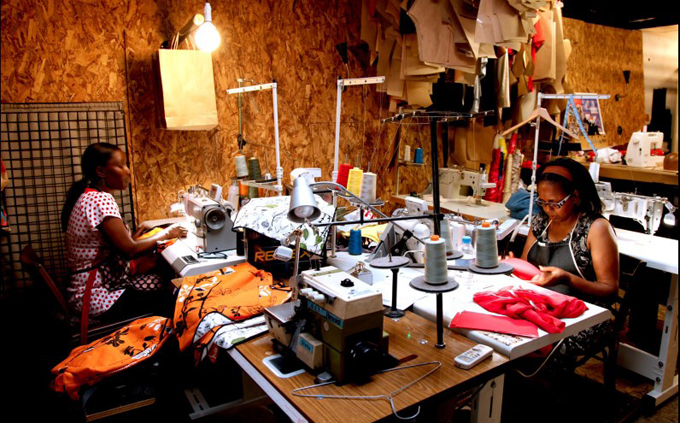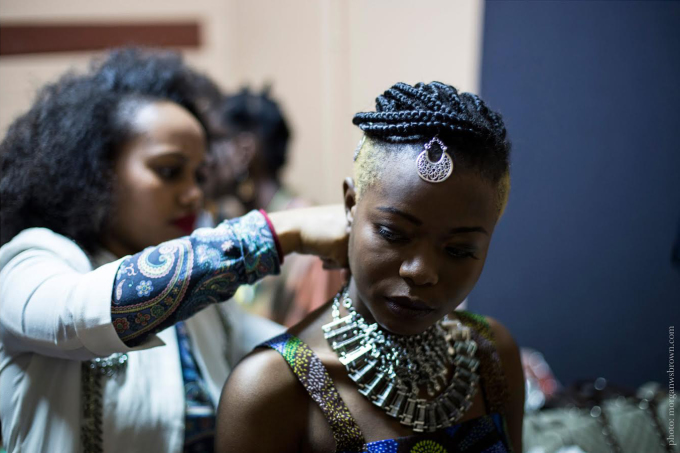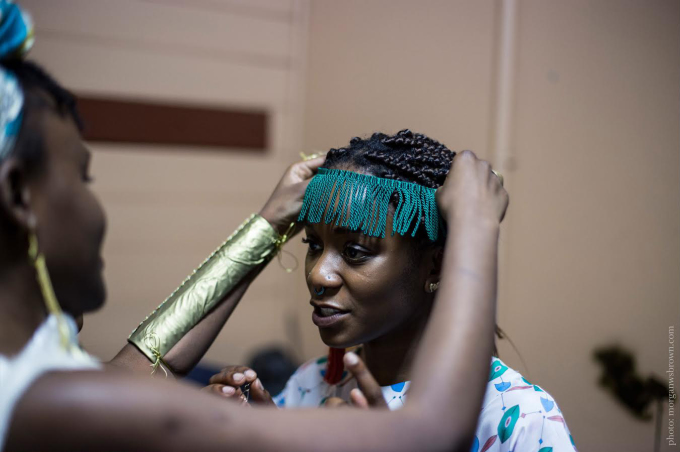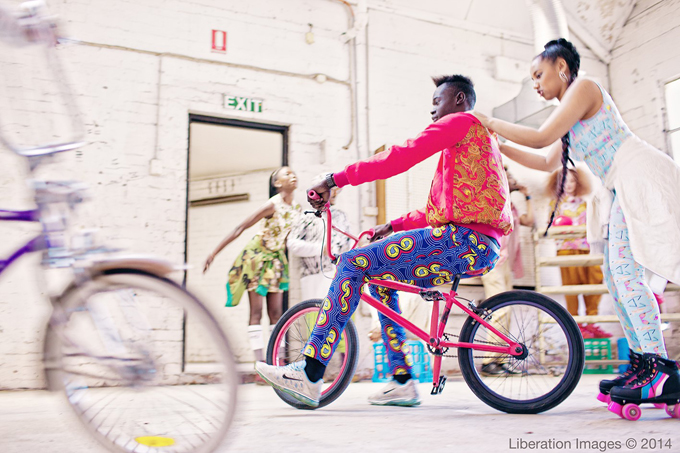
The Social Studio shop front in Melbourne. Photograph Mimi-Murtle + Co. 2014
Hearing about inspirational artists and projects is a regular part of life at Creative Time — the conversations wafting through our open-air office often contain the seeds of major projects, or new directions for our ongoing efforts like Creative Time Reports and the Summit. Two months ago one such conversation led me to the Australian artist Grace McQuilten, who helped found the Social Studio in Melbourne. Our Summit Curator of Engagement, Sally Szwed, returned from a trip to Australia where she’d encountered McQuilten’s pioneering project. McQuilten’s community development work evolved into a groundbreaking initiative in which artist-migrants from around the world receive job training, community support, and a space to manufacture and sell their creations. In addition to overcoming their limited access to job opportunities, the artists bring to their work their own cultural influences, expanding artistic possibility. I spoke with McQuilten about establishing Social Studio amidst the crescendo of anti-migrant rhetoric from politicians and the activists who were pushing back.
Creative Time Reports (Marisa Mazria Katz, editor): What is your relationship to the Social Studio?
Grace McQuilten: I came up with the initial concept but through a long process of consultation with local community members and particularly young leaders from different migrant communities in Melbourne. I don’t like taking credit for it because it really came out of a more iterative process. I’ve been working in community development for about four or five years, particularly with youth settlement in new migrant communities. It arose partly, I think, out of recognition of this incredible skill set, talent and interest in fashion and design in those communities. It is also about recognizing a gap in terms of accessing mainstream education and employment and other opportunities to showcase their work and to find an audience in Australia.
CTR: Would you talk a little bit about the process of reaching out to these various communities and what that was like for you? What were some of the topics discussed repeatedly when you were having these conversations?
GM: It started quite organically or informally. I had a studio at an arts precinct called the Abbotsford Convent in Melbourne, and while there I started volunteering with local community projects involving newly arrived migrants. Separately I was conducting an English-as-a-second-language training program in which I would go to housing estates in Melbourne with a high population of immigrants. The program focused on women who wanted to learn English but were isolated and couldn’t get to mainstream education classes, and so we would visit them at home to provide tuition.

The Social Studio manufacturing team. Photograph Eugenia Lim. 2012.
CTR: Why weren’t they able to get to those classes?
GM: Some of it was related to having children. Some of it was geographic isolation. Some of it was other sorts of cultural barriers that might have prevented them from being able to leave their family home and go to school. So we did this outreach program. We would match a teacher with a student, and we would go out to the house and do quite informal English-language tuition. A few different and really interesting projects happening around my studio involved training and employment for new migrant communities. I got involved in running some hospitality training programs because I had experience working in hospitality as a student, and it was really just through making friendships and relationships with those communities that this body of work started to develop into a full-time social enterprise, which is the Social Studio.
CTR: Why did you call it the Social Studio?
GM: The idea was not only to run programs or to offer a service but also to create a community. When looking at the underlying barriers that new migrants in Australia face in accessing employment and education, a lot of it comes down to not having a social network. It’s been quoted that around 60 percent of jobs are not advertised formally. People find out through word of mouth, and they find out through friends of friends and family or through previous work connections. When you’re completely new to a country and you have no social network, you’re already disadvantaged by that 60 percent of jobs that you don’t even know exist. And when you add to that not having local qualifications and not having local work experience, it becomes even harder to get that first job, or even to get the interview for that first job. We really wanted to create a space that would encourage both social connection and the creation of professional networks, in addition to the work experience and formal qualifications that then really give someone the full tool kit to be able to go out and look for work.

The Social Studio fashion show, 2015. Photo courtesy of Morgan W.S. Brown.
CTR: In addition to the barriers to employment for migrants—including for those who arrive and basically are without a social network that could lead them to those jobs not advertised—what are some of the other challenges that migrants might be facing in Australia?
GM: Probably the biggest one is systemic and structural racism. Some of the other main barriers are not speaking English as a first language or not having an Australian accent. They may speak English really well, but they do so with a thick accent. They may also have a name that’s very different or an appearance that people associate with fear of war overseas, fear of terrorism and fear of the unknown. All of those play a really big role. In terms of the work we’ve done at the Social Studio, we’ve worked with quite a large proportion of migrants from Africa. Mass migration to Australia from Africa is quite new (it started around the early 2000s), and so that group was facing a lot more of this sense of otherness and cultural difference.
CTR: How is this wave different than previous ones?
GM: It was a new wave of migrants, and there was a lot of fear and racism that were triggered by 9/11—the sort of fear of terrorism worldwide you see polarizing communities quite vividly now.
CTR: How do people access the Social Studio? Is it by word of mouth, or do you go into communities and recruit?
GM: We use different methods. A lot of people come to us because family or friends have told them about it, or they’ve heard about it through maybe an article in the paper because of an event that we’ve held or something like that. But we also work quite closely with schools and social workers across a range of services, because our focus really is on providing that bridge for people who are either dropping out of high school early or who are long-term unemployed and just really struggling for an entry point back into mainstream employment. So we do a combination of outreach trying to target people whom we think could most benefit from being involved and then also just welcoming people who come to us themselves.
They’re continuing on with aesthetic traditions from their home countries, from their own cultures, then transforming that into contemporary work that’s meaningful for them but also has a broader audience.
CTR: And is there an underlying hope that this is not just a place to socialize, but one where people will eventually have a skill set that they can then earn money from?
GM: We create employment within the studio. For instance, more than 80 percent of our staff are from refugee backgrounds.
CTR: Where are some of the places they hail from?
GM: On the manufacturing team at the moment we have two men from Burundi and a woman from Ethiopia. On our retail team we have a woman from South Sudan and a man from the Congo. Then in our café we have two women from the Karen state of Burma, a woman from Liberia, and another woman from South Sudan. So it’s a bit of a melting pot of different languages, religions, cultural backgrounds, geography and the works. In addition to that, we try to make sure that we’re providing people with opportunities to find work and get work in the mainstream outside of Social Studio. We also have a lot of young artists who want to launch their careers in the arts. We’ve supported them with their first exhibitions and by helping them find out where else they can go to show their work. We’ve also supported a lot of young designers in launching fashion labels, for example.
CTR: How would you say the traditions or aesthetics of many of your constituents’ native countries are transformed or employed when they work in the Social Studio?
GM: One of the nicest things about the studio is that it is an incredibly open, creative space where people come. They’ve got access to materials, but they’re kind of continuing on with aesthetic traditions from their home countries, from their own cultures. They are then transforming that into contemporary work that’s meaningful for them but also has an audience that’s broader than just their own local community. We embrace traditional techniques of weaving and embroidery, traditional styles of tailoring as well as creating more contemporary and commercial products.
CTR: Do you have an opportunity for people to sell within the space?
GM: We have a design team that collaborates with the students, and the students come up with textile designs and ideas for new pieces. We then manufacture those in-house with our paid manufacturing team, who are all full-time employees—they make the products that go into this store. From there, if some of our students want to launch their own labels separately from our label, we encourage them to do that and help them build the business skills that they need to be able to sell both at the studio and elsewhere.

The Social Studio fashion show, 2015. Photo courtesy of Morgan W.S. Brown.
CTR: You’ve had a new prime minister elected recently, one whose party affiliation is far more liberal than that of the previous prime minister, who had strong xenophobic policies.
GM: Absolutely.
CTR: Do you see the new government making attempts to replicate the kind of work you are doing with Social Studio? Is there any interest on a bureaucratic level? I am asking because it would seem that the integration of refugees has been a real struggle in Australia, and perhaps your work could become a kind of model?
GM: We’d love to see the government recognize the success that we’ve had and try to help to roll that out to create greater impact for more people in the community, but it’ll be a slow process. We haven’t seen that yet, and unfortunately the issue of seeking asylum in Australia has been so politicized over the last decade that even a more progressive government tends to fall back on a sort of hard-line mantra about keeping asylum seekers out and not accepting refugees. They do this in order to maintain their voter base, which is more conservative and responds well to that sort of hard-line approach, but there’s a lot of activism and campaigning going on to try to break that and change attitudes. I think one of the most exciting things about the Social Studio is that we’ve been able to be political in a not necessarily direct or obvious way. We have pumped out so much imagery and so many positive stories that we are counteracting the constantly negative narratives about refugees and asylum seekers. By showing the rest of Australia how successful Australians can be in welcoming refugees and asylum seekers, we hopefully will start to change those attitudes and will eventually see more systemic or structural change.
CTR: Is there a story of one of your members who was radically transformed by the process of working with the Social Studio?
GM: There are so many. One that’s quite amazing is a young girl from South Sudan called Atong. She came to the studio when she was about 16 because she had always loved fashion and couldn’t study it in her high school. They didn’t offer any programs. She started coming first on weekends just to be involved with the studio and to build up her skills, and then she started coming as much as she possibly could. We helped her build a portfolio that got her into the top design college in Melbourne. She then graduated from that design college and launched her own fashion label, which has been really successful so far. All the while she was working in our retail store and training our younger manufacturing team and designers, alongside teaching skills within her own migrant community.
A lot of the artists who come to us have a completely different understanding of what visual art is—it’s not a thing that goes on a wall in a gallery, but it’s very much embedded in a whole range of aesthetic traditions.
CTR: And has she attracted other people from her community to the Social Studio?
GM: Yeah, absolutely. She’s a role model.
CTR: Do many of the artists receive some formal training or a formal education from you that then enables them to head into a university setting?
GM: We partner with RMIT University’s School of Fashion and Textiles (http://www.rmit.edu.au/about/our-education/academic-schools/fashion-and-textiles/), and we deliver a certificate III in clothing production and a certificate IV in textile design and development. The next step after these certificate programs is a diploma. It is all delivered on-site at the Social Studio. It is really good for students who’ve lost confidence, who’ve maybe dropped out of mainstream school, who need more time just to build up their language and numeracy skills and then to go back into mainstream school having done all that.
CTR: The Social Studio has several components: fashion, art, hospitality, and design. In terms of the visual arts, what would you say you’re seeing a lot of?
GM: This is a great question, and in Australia it’s something that I find quite frustrating. A lot of the artists who come to us who’ve been practicing in their home countries, say whether it’s in the Horn of Africa or in the Middle East, have a completely different understanding of what visual art is. So it’s not necessarily a thing that goes on a wall in a gallery space, but it’s very much embedded in a whole range of cultural practices and aesthetic traditions that include making objects for the home or objects that you’d wear as adornments or objects that might have a ceremonial kind of value. It could be things that are traded, for instance. It could be clothing. It could be all kinds of things, and in particular what we’ve found is incredible skill and talent in textile design. So visual artwork essentially, but it’s utilitarian in that it’s turned into a fabric that’s then worn. We’re trying to sort of help people see a range of practices that are embedded in life as well as things that you can look at or put on a wall or experience in a more traditional exhibition setting.
CTR: How do you fund the project? Is it self-sustained or does it receive money from the government?
GM: It’s about 50 percent self-funded through our various trading activities, and the rest we raise through mostly grants from foundations, and that’s because at least half of what we do is the education and training parts of our work, which don’t generate income because we provide everything for free. So we need to be able to fund-raise to support that, but over time we’re hoping to build up that self-generated revenue so that we’re less reliant on grants long-term.
CTR: You know, it sounds to me as if this is a really incredible and also sustainable model that can be used in so many places around the world as thousands of refugees continue to leave their home countries and venture to Europe. Have you been approached at all to cultivate or to set up abroad?
GM: We’re quite passionate about a sort of ground-up community-led approach to community development because you have much greater buy-in from everyone involved and a much greater sense of ownership. I think that contributes to the project’s sustainability long-term. So what we’ve done, instead of sort of franchising the model, we’ve worked very closely with a group in Sydney that wanted to start up the same model. They’ve now launched their own organization called the Social Outfit, which is in Newtown, a suburb of Sydney, and they have a fashion label, a manufacturing team and some training programs. I think what was maybe even more exciting than that was when we supported one of our graduates, Abuk Bol, to start her own social enterprise in one of the outer suburbs of Melbourne. She’s from the South Sudanese community, and it’s entirely managed and run by women from the South Sudanese community. It is called the Twich Women’s Sewing Collective.
So for us, that’s a really exciting way to see the model develop and extend itself. We wouldn’t rule out bringing the Social Studio to other places, as long as we could ensure that the local community in that place managed it and felt very well connected to it.
CTR: What do you see happening to the Social Studio 10 years from now? How do you see it progressing?
GM: I think there’s an enormous amount of opportunity for us to grow and develop and to increase the number of jobs and the amount of training we can provide. But I think it’s also really complex and difficult work. So we have to be realistic about how we do that while holding on to our values and integrity as we grow so that we don’t just become an image without actually delivering real outcomes for those involved. I have a sort of measured approach to growth and development, but we’re still ambitious and still hopeful and excited about the future.

The Social Studio warehouse photo shoot. Photograph Liberation Images. 2014.

